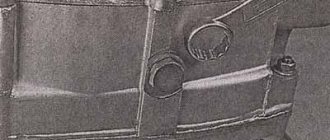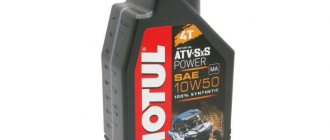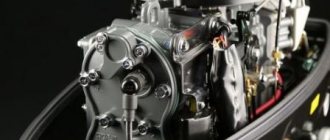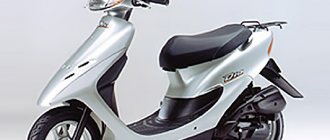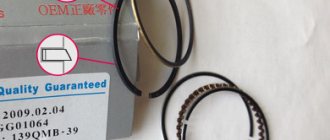A gearbox is a mechanism for reducing the speed of the driven shaft in order to increase torque. Simply put, it converts high clutch shaft RPMs into low (but powerful) wheel RPMs. The gearbox consists of several gears and bearings. All its parts are in constant rotation when driving and are under very serious load.
Therefore, the key to long-term performance of the gearbox is good care of it. Fortunately, maintenance is very simple: you need to change the oil in the gearbox in a timely manner. I believe that the oil should be changed once a year or every 2 thousand km.
In order to change the oil in the scooter gearbox, we will need the following tools:
- container for draining old oil
- key for 10
- a syringe or, at worst, a funnel
- transmission oil
What to fill the gearbox with?
There are three options.
1. There is a special Motul Scooter Gear gear oil. That's what I used at first. The disadvantages of this oil are as follows: the tube has a volume of 150 ml, while in my scooter the gearbox requires 90 ml, that is, one tube is one and a half refills, neither this nor that. And it is inexplicably expensive (about 250 rubles). The only plus: the convenient tube spout.
However, you can use any other automotive gear oil with a viscosity of 80W-90 or 75W-90. For the same money you can buy a liter of “non-scooter” oil, and it will work exactly the same.
2. Since the scooter gearbox does not contain hypoid gears, any motor oil with a viscosity of 10W-30 can be used as transmission oil. Motor oil is even preferable if the scooter is used in the off-season at temperatures below +7 ° C, because it is more liquid.
Characteristics and tuning of the QMJ 157 engine
Various two-stroke and four-stroke engines are used to power Chinese scooters. The most popular are four-stroke motorcycles, which include the QMJ 157 power unit. Engine capacity is 9.2 liters. With. has one 150cc cylinder and is copied from the Japanese GY6 Honda engine model. The drive from the motor to the drive wheel is carried out through a variator included in the delivery package of the engine. Wanting to increase the speed that a motorcycle or scooter develops, they often perform engine tuning.
Engine QMJ 157 - characteristics and general description
Like most equipment produced by Chinese manufacturers, the QMJ 157 four-stroke engine is reproduced from its Japanese counterpart. The power unit installed on a Honda scooter was taken as a prototype. The motor has undergone long-term testing under various operating conditions, proving itself to be reliable, trouble-free and durable.
Various two-stroke and four-stroke engines are used to power Chinese scooters
All that remains for Chinese engineers is to adopt a proven design and begin mass production. How successful the motor turned out can be judged by its area of application. The one hundred and fifty-seventh engine model, the power of which is enough to accelerate a full-size two-seater scooter, is today installed both on expensive scooter models - Honling, Forsage, and on budget scooters like the Viper Storm 150. This power plant has become legendary among fans of Chinese scooters.
The limited speed threshold of the scooter, associated with the relatively small cubic capacity of the engine and the developed power, forces tuning enthusiasts to modernize the engine.
When planning to improve a fairly good motor, you should first familiarize yourself with its technical characteristics. Let's consider the operating parameters of the engine.
Compared to 50cc four-strokes, it has quite good cubic capacity and power. The cylinder has a volume of 149.6 cm3, and the maximum power reaches 6.8 kW. The piston has a diameter of 57.4 mm and a stroke of 57.8 mm. At maximum power, the revolutions reach 7.5 thousand per minute. At 6 thousand revolutions per minute, the maximum torque is 9.8 Nm. Idle speed ranges from 1600 to 1700 per minute. The engine weighs a little - 27 kg.
Before you start using it, you should break in the engine and drive the scooter for 2000 km in compliance with the speed limit. With proper running-in, the engine service life reaches 25,000 km. The motor quickly and dynamically accelerates the scooter with the driver and passenger. A run-in engine does not require intervention and can operate for a long time without major repairs. Then it will be necessary to replace the rings, which does not require a major investment.
This power plant has become legendary among fans of Chinese scooters.
Engine device
Beginning scooter riders, if they need to repair the motor, try to understand its design. Diagram 157QMJ will help you obtain information about the structure of the power unit and its components. Having dealt with it, you can not only purchase the necessary spare parts for the 157 QMJ engine, but also correctly perform the work of assembling and disassembling the engine. Structurally, the motor is practically no different from its GY6 counterpart. The 157 QMJ has the same cylinder-piston group, clutch, crankcase, camshaft and muffler.
The bearing numbers, sizes of silent blocks and gears, diameters of the variator pulleys and the design of the kickstarter, generator and electric starter also correspond. The engine is cooled by the oncoming air flow. Starting is carried out from an electric starter or kickstarter. Torque is transmitted through a variator, which is an automatic integral transmission.
Depending on the design features of the scooter on which the engine is installed, it can be equipped with a CVT having an extended box. The engine is equipped with a standard power system, providing fuel consumption reduced to 2.5-3 liters per hundred. The power unit operates quite quietly, providing almost silent acceleration of the scooter during maneuvers.
The motor is equipped with a standard power supply system
Engine tuning QMJ 157
Why do they tune a fairly reliable engine? Those who like to modernize their scooter explain the need for tuning by the limited speed threshold and the desire to increase power. The fact is that the engines of most scooters, having reached maximum speed, begin to run wild. This not only increases fuel consumption, but also significantly reduces the service life of the engine.
The design of the engine makes it possible to increase its cubic capacity from 150 to 170 cubic meters. To modernize, it is necessary to purchase a number of spare parts, as well as correctly perform the work of disassembling and assembling the motor.
It is important to properly break in the power unit after tuning. Let us dwell in detail on the complex of these issues.
Required spare parts
To carry out engine modernization work, you must purchase the following spare parts:
- four-valve cylinder head with a sports camshaft. The head includes rubber seals, a set of studs, a gasket and a camshaft chain;
- carburetor having an intake manifold with a diameter of 30 mm and equipped with a gasket. Installing a CVK Racing sports carburetor will provide power to the engine after increasing the cubic capacity;
- working cylinder with a sleeve with a diameter of 61 mm and a piston of the appropriate size. You will also need a piston pin, a pair of circlips, compression rings, an oil ring with a retainer and a paper gasket.
After tuning, it is important to properly break in the power unit
. By performing simple calculations, you can make sure that replacing a standard piston with a diameter of 57.4 mm with one increased to 61 mm will increase the volume of the working chamber to 169 cubes. At the same time, the piston stroke length, equal to 57.8 mm, remains unchanged.
Disassembly
Having purchased all the spare parts necessary for tuning, you should study the procedure for disassembling the engine. It is technically possible to complete the entire scope of work without dismantling the power unit itself from the scooter frame.
The work must be performed according to the following algorithm:
- remove the rubber mat and dismantle the seat. You will also need to remove the trunk, the plastic trim around the driver's seat and the exhaust pipe. The muffler remains in the same place. It is important not to confuse the locations of bolts of different lengths;
- dismantle the air purification filter assembled with the power supply system. Instead of the standard filter, which has a reduced throughput, you will need to install a Uni Filter. It will ensure the purification of the required amount of air for a 170 cm3 engine. To remove the carburetor, you will need to disconnect the throttle cable and remove the clamps from the gasoline hoses;
- unscrew the plastic covers that protect the engine from contamination and provide additional circulation of cooling air flows. The plastic casing is removed by unscrewing a group of screws. The plastic is then easily removed. Don't forget to cover the floor with old rags to absorb any oil that drips during disassembly;
Before tuning, study the procedure for disassembling the engine
- Unscrew the 4 M4 bolts securing the cylinder head cover. After this, the cover, under which the rubber gasket is located, will quickly be removed. Don't forget to disconnect the breather hose from the air filter. It will then be mated to the new oil trap;
- unscrew the M12 nuts securing the camshaft and cylinder heads. Remove the upper camshaft mounting elements, ensuring that it does not move. Unscrew the chain tension adjustment cover and loosen the tensioner fastening with a screwdriver. Next, you need to remove the timing chain from the camshaft sprocket;
- unscrew a pair of M8 bolts securing the cylinder head. Carefully remove the cylinder by moving it along the studs. The metal gasket will require replacement as it cannot be reused. Use thin pliers to remove the piston pin retaining ring, after which the piston can be disconnected from the connecting rod.
- install gaskets and rings. It is important not to block the channel in the cylinder intended for lubrication of the cylinder head. When installing compression and oil scraper rings, they should be placed so as to ensure that the gaps are located at an equal angular distance;
- Carefully install the piston inside the cylinder complete with rings. A small amount of lubricant will make the piston installation operation easier;
- Apply sealant to the heat-resistant paper gasket, align with the cavities and channels, and then install the cylinder along the studs. The IN marking on the piston should point towards the intake manifold;
- connect the piston after the connecting rod and pin holes match. Install the cotter pins and make sure the retaining rings are secure. They must coincide with the grooves of the piston. Before starting work, it is necessary to apply lubricant to the piston pin.
Remember that the increased height of the four-valve head will require replacing the four studs that secure the cylinder-piston group to the cylinder head.
How should the studs be installed?
To unscrew the original studs, a standard technique is used, which is used by engine tuning enthusiasts. Screw two nuts onto the threads of the stud and use wrenches to press them tightly together. Then you need to unscrew the bottom nut by rotating it counterclockwise. Before screwing in new studs, apply blue sealant to the threads to prevent turning. The pair of cylinder fixing fasteners on the right side of the engine does not need to be removed.
Assembly
Assembly work is carried out in reverse order. Procedure:
All that remains is to install a new timing chain, making sure that the marks on the engine housing and the generator match. Then you will need to put the cylinder head on the studs, install and fix the camshaft, and also adjust the valve clearance in the range of 0.05-0.1 mm. The final steps are installation of spark plugs, oil catcher, carburetor and air filter. Now you can try to start the engine and start running it in.
157 QMJ engine - characteristics, running and reviews
The performance of a scooter with a tuned engine will increase significantly. It will be able to accelerate to almost 100 km/h. It is important to ensure normal grinding of the rings. To do this, the first start of the engine should not exceed 5 minutes, and the speed should be 50%. After the engine has cooled, you can restart the engine for 10 minutes and slightly increase the speed. After the third 15-minute start, wait until the engine cools down and check for oil leaks. According to owner reviews, the upgraded engine will delight you with improved dynamics and pleasant sound.

